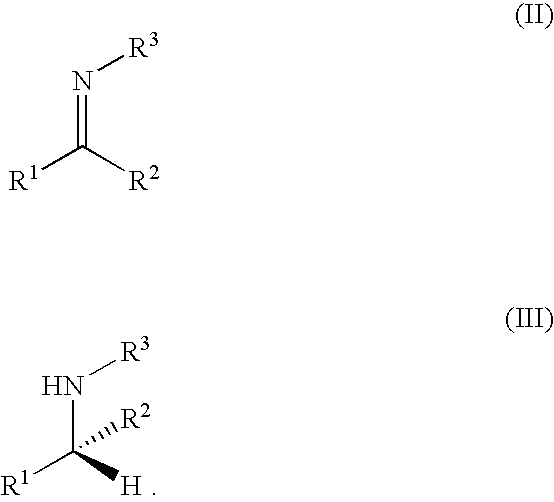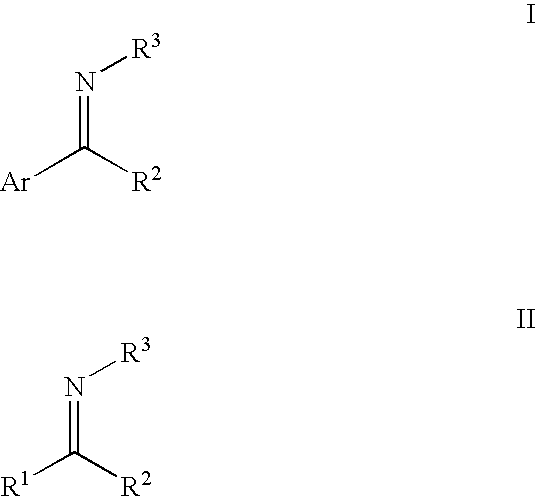Process for hydrogenating unactivated imines using ruthenium complexes as catalysts
a technology of ruthenium complexes and catalysts, which is applied in the preparation of amino compounds, organic compounds/hydrides/coordination complexes, and physical/chemical process catalysts. it can solve the problems of reducing the analogous cn function, affecting the chiral amine production method, and presenting a major challeng
- Summary
- Abstract
- Description
- Claims
- Application Information
AI Technical Summary
Benefits of technology
Problems solved by technology
Method used
Image
Examples
example 1
Preparation of the Ligand R,R—DCYPPACH and Complexes
[0077]R,R-1,2-Bis(dicyclohexylphosphinamino)cyclohexane (RR—DCYPPACH): A solution of chlorodicyclohexylphosphine (4.07 g, 17.5 mmol) in toluene (20 ml) was added dropwise to a solution of R,R-1,2-cyclohexyldiamine (1.0 g, 8.75 mmol) and triethylamine (2.0 g, 19.4 mmol) in toluene (20 ml) and the resulting suspension stirred for 6 hours at room temperature. It was then evaporated to dryness, the solids washed with ethanol (2×10 ml) (in order to remove triethylammonium chloride) and hexanes (3×5 ml) and dried under vacuum. Yield=3.86 g, 87%. 1H NMR: 0.95-2.38 ppm (m); 31P{1H} NMR: 51.3 ppm (s).
[0078]RuHCl(R,R—DCYPPACH)(PPh3): Tetrahydrofuran (10 ml) was added to RuHCl(PPh3)3 (1.50 g, 1.63 mmol) and R,R—DCYPPACH (900 mg, 1.77 mmol) and the mixture refluxed for 4 hours under argon. The mixture was filtered and the brick-red solution used as a stock solution, since the product is an oil at room temperature. 1H NMR: −16.70 ppm (dt, 1H, R...
example 2
Preparation of Imines
[0080]All imines were prepared by refluxing stoichiometric amounts of the appropriate ketone and amine in toluene or THF over 4 Å molecular sieves until there is no further change in the composition of the mixture with time. The excess ketone and amine are removed under vacuum, and the resulting imine purified by distillation.
Structure of Ligands
[0081]
example 3
Catalytic Hydrogenation
[0082]The required substrate was added to a mixture of the catalyst precursor and KOiPr or KOtBu in a 250 ml Schlenk flask (benzene or THF was added to dissolve solid imines), which was then cooled to liquid nitrogen temperature. The flask was evacuated under vacuum, filled with H2 gas, closed and allowed to gradually warm to room temperature. The mixture was stirred vigorously until either hydrogenation is complete or no further change in the composition is observed (NMR). A typical procedure for the hydrogenation of N-(1,5-dimethyl-4-hexenylidene)aniline is illustrated below:
[0083]A solution of N-(1,5-dimethyl-4-hexenylidene)aniline (2.0 g) in benzene (2 ml) was added under a flow of hydrogen gas to a mixture of RuHCl(R,R—BINAP)(R,R—CYDN) (5 mg) and KOiPr (5 mg) in a Schlenk flask. The flask was then cooled to liquid nitrogen temperature, filled with H2 gas, closed and allowed to gradually warm to room temperature. The mixture was vigorously stirred for 24 h...
PUM
| Property | Measurement | Unit |
|---|---|---|
| pressure | aaaaa | aaaaa |
| pressure | aaaaa | aaaaa |
| pressure | aaaaa | aaaaa |
Abstract
Description
Claims
Application Information
 Login to view more
Login to view more - R&D Engineer
- R&D Manager
- IP Professional
- Industry Leading Data Capabilities
- Powerful AI technology
- Patent DNA Extraction
Browse by: Latest US Patents, China's latest patents, Technical Efficacy Thesaurus, Application Domain, Technology Topic.
© 2024 PatSnap. All rights reserved.Legal|Privacy policy|Modern Slavery Act Transparency Statement|Sitemap



